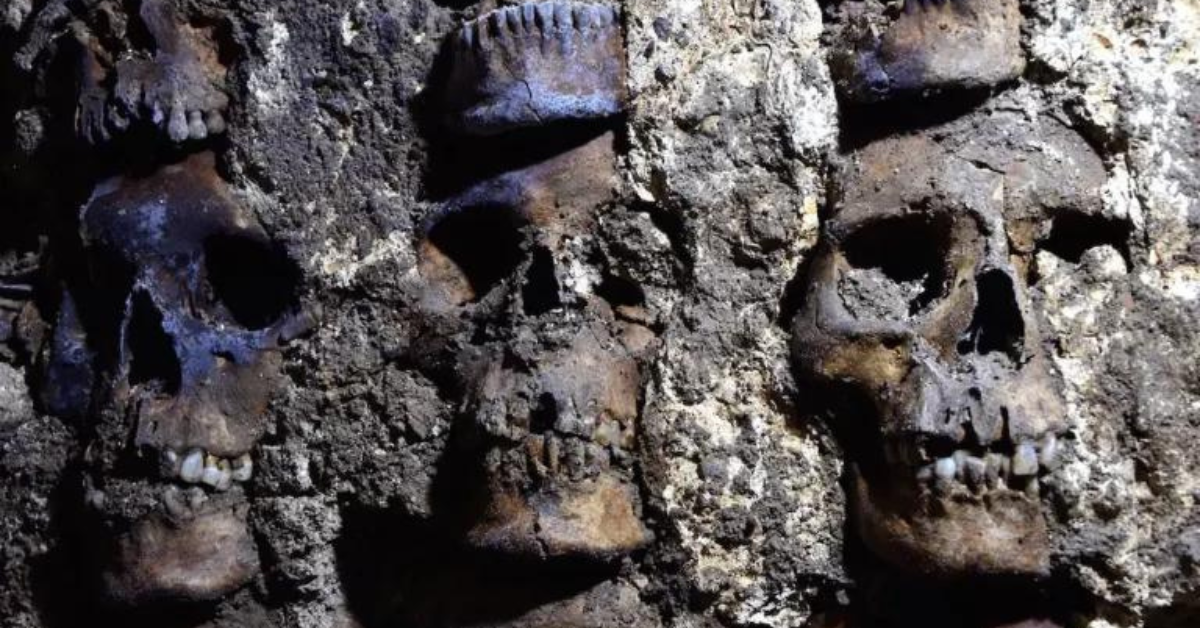The Aztecs ritually sacrificed people to appease their gods. They displayed the heads of their dead on enormous, cylindrical racks called tzompantli, constructed using rows of skulls mortared together. The Aztecs used these towers to show off their empire’s might to enemies and invaders.
Last week, Mexico’s National Institute of Anthropology and History (INAH) announced that researchers had discovered a section of one such tower under the ruins of Mexico City’s Templo Mayor. It contained 119 skulls from men, women, and children.

Archaeologists first discovered this tower, called Huei Tzompantli, five years ago. The skulls date back more than 500 years. The new section they found brings the tower’s skull total to 484, INAH said in a statement.
The new set of skulls was discovered in March, buried more than 10 feet under the streets of the Mexican capital. (Mexico City was built on top of the Aztec empire’s capital, Mexico-Tenochtitlán.)
“The Huei Tzompantli is, without a doubt, one of the most impressive archaeological finds of recent years in our country,” Alejandra Frausto Guerrero, Mexico City’s culture secretary, said in a statement. “It is an important testament to the power and greatness achieved by Mexico-Tenochtitlán.”
A tower of heads
Archaeologists said Huei Tzompantli was built some time between 1486 and 1502. It likely sat in a temple dedicated to Huitzilopochtl, the Aztec god of war and human sacrifice.

The tower is more than 16 feet wide and consists of row after row of skulls impaled on long wooden poles, like beads on a string. Those rows formed the walls of the tower.
The skulls all faced inward, toward the tzompantli’s hollow center. According to the Associated Press, the Aztecs may have let the flesh on the heads rot off before mortaring the rows of skulls together to cement the tower in place.

The archaeologists who discovered the new section of the tower expected the skulls to have come from male warriors But they were surprised to find skulls belonging to women and at least three children in the mix.
“Although we can’t say how many of these individuals were warriors, perhaps some were captives destined for sacrificial ceremonies,” Raúl Barrera Rodríguez, head of INAH’s Urban Archaeology program, said in a statement.
Those sacrificed captives were likely “turned into gifts for the gods or even personifications of deities themselves,” he added.
Skull towers were declarations of power in the Aztec empire
According to Barrera, the Aztecs built tzompantli like this one were to demonstrate the might of their empire to enemies. Prisoners of war were sacrificed to Aztec gods and displayed on these towers.

The Aztecs practiced these ritual killings because they believed the sacrifices kept their the gods alive and ensured the world would keep turning, according to the INAH. Such sacrifices, called nextlahualtin (which translates to “payment of debts”), were seen as a way to curry favor with the divine.
“Human sacrifice in Mesoamerica was a commitment that was established daily between human beings and their gods, as a way that affected the renewal of nature and ensure the continuity of life itself,” Barrera said.

Many of the Aztec’s sacred towers were lost when the Spanish invaded Aztec lands in the 16th century. As Hernán Cortés’ forces overtook Mexico-Tenochtitlán, they destroyed the tzompantli there.
That’s the reason, according to Barrera’s team, that they’ve only uncovered sections of this tower so far: It was razed and scattered across the city.
